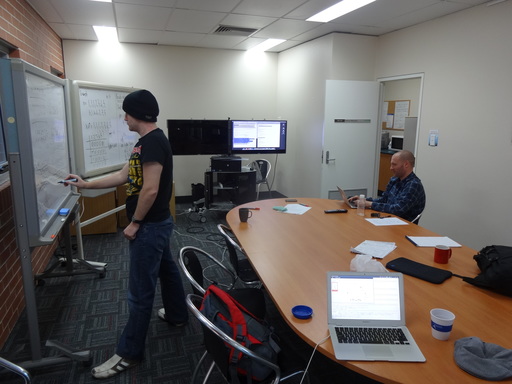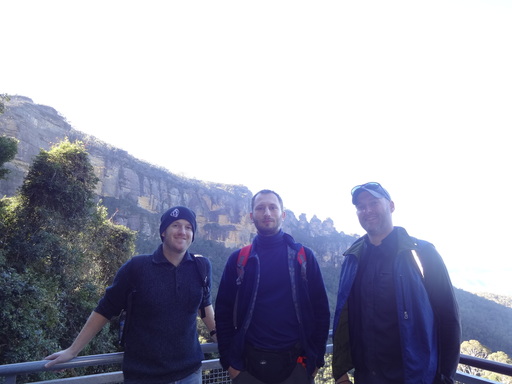Archive
Computing Partition Monoids – 3 weeks down under
First of all, we have some name clashes, simply because now there are many persons named James in semigroup theory. So to get this right, here are the names appearing in this story, in alphabetical order:
- JE James East, University of Western Sydney
- ENA Attila Egri-Nagy, University of Western Sydney
- JDM James D. Mitchell, University of St Andrews
Pictorially:
This is a story of the latest development of the Semigroups package, but let’s put things into perspective.
In 2004 JDM inherited the Monoid package with the task of turning it into a GAP4 package as it was originally developed for GAP3. This was done, but after that he became unsure whether it was worth investing more time into the development. He felt that there was not much interest.
In 2010 ENA went St Andrews, determined to squeeze out a release from JDM with some new features needed for SgpDec. One man crowd with banners WE LIKE, WE NEED MONOID! RELEASE EARLY! RELEASE OFTEN! Apparently, this was convincing. JDM started to revise the code.
Around this time Monoid was renamed to Citrus. Much to the excitement then later disappointment for orange growers in Florida.
In 2011 JDM came to Eger, Hungary for the cute little algebra conference A^3. He started to write code for SgpDec and consequently making more upstream changes in Citrus.
Here comes the key point in this story. When including new code for partial permutations JDM was faced with a huge amount of copypaste-then-change-a-bit code. This did not feel right. There was an obvious need for more abstract code, meaning that most algorithms for transformation semigroups work for other semigroups as well. This is a very important moment for computational mathematics, as it is a prime example showing that math and computing is not a one-way relationship. Insights in software development can lead to more abstract and cleaner mathematical descriptions.
In 2012 the BIOMICS project started and they got the idea that inviting two developers is twice as good as inviting one, so JDM and ENA again had an opportunity to work together again (hinting the general semigroup action framework), again and again.
But it is time for JE appear on the scene. He and JDM met in Portugal (not for the first time) and talked about partition monoids. These are very interesting structures but without any efficient transformation representation, so these are objects that can really put the general framework to test. JDM in his energetic way did some coding to implement partition monoids in Semigroups, but more consultation was needed. This was not so easy since JE and JDM normally live at the other ends of the world.
In 2013, at the University of Western Sydney a new research centre for Mathematics (called CRM) was formed. The Centre have a program for inviting distinguished international visitors to work with UWS researchers. The more people the visitor can work with the better. JDM was an obvious candidate, and the visit did indeed happen between June 30-July22.
We took over the small meeting room for two weeks. Algorithms were discussed and tried on the board first. The whiteboard space was very limited, but nowadays you just take a shot with your mobile phone and erase the board.
 Then the algorithms were immediately turned into GAP functions and methods and tested against the hand-calculated examples and known mathematical results.
Then the algorithms were immediately turned into GAP functions and methods and tested against the hand-calculated examples and known mathematical results.
 JDM’s original estimate was one week, but it actually took 2 weeks to get some tangible results. As software development goes, the estimate was surprisingly accurate.
JDM’s original estimate was one week, but it actually took 2 weeks to get some tangible results. As software development goes, the estimate was surprisingly accurate.
One example of these new computational results was the D-class picture of the full partition/Brauer monoids. Something that human eyes had never seen before. All in good timing for doing some marketing at the GAIA conference further down in Melbourne. JE gave a talk featuring these new images and there was also a backstage software demo for potential `customers’.
At GAIA we also observed something which must be a generational issue. We got the impression that not long ago mathematicians wrote and sang songs at conferences. What do we do now when we go back to the hotel room? We write code. 🙂 Also, the last row in the lecture room is not used for sleeping any more, it is used for software development. This is of course just an observation, not a judgement, but it seems that academic life was a wee bit more relaxed before.
All in all, as one can see in bitbucket commit messages and in the upcoming preprints, this was a very productive research visit and we also had time for some travel and bushwalks. Maybe a bit taxing on the families, but hopefully the 3 weeks of geek-life will be forgiven.
